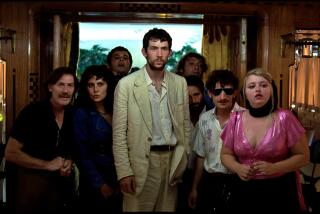Book review: ‘Zona’ by Geoff Dyer
Zona
A Book About a Film About a Journey to a Room
Geoff Dyer
Pantheon: 230 pp., $24
Imagine going to the movies but, for one reason or another, you can’t see or hear anything on-screen. Fortunately, you can still experience the film with the help of a friend tugging on your sleeve excitedly and guiding you through the movie by describing what they see and hear, and, for added color, what it means. How much you’d gain from that experience would depend on your level of patience, certainly, but also on the quality of the film and your friend’s abilities. Is he or she familiar with the movie? A fan? And is your friend sharp enough to paint an entertaining picture?
These, roughly, are the conditions constructed by novelist and essayist Geoff Dyer in “Zona,” a book-length effort to summarize Andrei Tarkovsky’s 1979 film “Stalker” from opening shot to fade-to-black. Dyer’s mission sounds impossible on the surface, but putting sound and visuals into words has always been the challenge for arts criticism. The idea is no stranger to book-length explorations, either, particularly in recent years with Soft Skull Press’ loving Deep Focus Series, which enables writers to deconstruct specific movies, and Continuum’s obsession-friendly “33 1/3” series with its open-ended examinations of classic albums.
And, luckily for the moviegoer in this case, Dyer is the sort of writer with whom you feel in good hands for all the above conditions, especially the last one, which has been proved multiple times in the London-based writer’s various books including his deliriously addictive, imaginary accounts of jazz musicians’ lives in “But Beautiful” and quasi-memoir “Out of Sheer Rage,” which transformed the act of not writing aboutD.H. Lawrence into an investigation of reading and writing itself.
Still, in his new book, Dyer admits that undertaking an expansive, linear summation of a Russian art film, scene by scene, flirts with madness: At one point he asks the reader with a faint air of incredulity, “Do you think I would be spending my time summarizing the action of a film almost devoid of action … if I was capable of writing anything else?”
But ultimately, testifying to the greatness of an underappreciated work of art is the core purpose of criticism, and Dyer has delivered a loving example that’s executed with as much care and craft as he finds in his subject.
As someone who has never seen “Stalker,” it’s difficult to say whether this book is best suited for fans of the film, but Dyer approaches the film with such good-natured depth that he allows room for neophytes. An enigmatic, slow-moving “road movie” colored by striking cinematography, “Stalker” follows its mysterious title character as he guides two clients called Writer and Professor through an uncertain and surreal journey in a post-industrial wasteland called the Zone on a quest for the Room, a mystifying yet apparently quite ordinary place where your deepest wishes can come true.
Though Dyer admits that his subject is a film that could be summarized “in two sentences,” he finds elements along the way that will keep even non-cinéastes onboard. While he dedicates ample energy to how the movie’s deliberate pacing runs contrary to modern cinema (defined by Dyer as “Tarkovsky-time”), its troubled production and the nuts and bolts of its deceptively simple parts, Dyer’s rich, restless mind draws the reader in with specific, personal details that form a welcome paradox in a film that seems dedicated to appearing so superficially general (just look at those character names).
In Tarkovsky’s Zone, Dyer sees echoes of the Russian gulags, the haunted nature of post-meltdown Chernobyl and the chaotic first hours of Sept. 11 — an impressively broad palette for a film more than 30 years old. And though Dyer colors his book with a staggering arsenal of cultural references from Rilke, recording artists Thievery Corporation and even “bumfights” videos with an acrobatic grace, it’s the book’s slow reveal of Dyer’s interpretation of the Zone that eventually leaves the greatest impact.
For all the witty, self-referential asides that can make the book feel like the smartest “Mystery Science Theater 3000” episode ever written, it’s Dyer’s emotional tie to Writer’s journey and the wish fulfillment of that vocation that stay with you the longest after the lights finally come up.
Devoting an entire book to an obscure ‘70s art film is a fairly radical undertaking, particularly in an age when such films, once seen only on static-ravaged videocassettes passed hand to hand and at one-off revival screenings, are mostly faded memories. While it’s that scarcity that may have contributed to “Stalker’s” prominence in Dyer’s mind when he discovered it in his youth, the movie is only a click away on Netflix for the rest of us. It was even posted on YouTube by its studio, Mosfilm (a little knowledge of Russian goes a long way toward finding it).
Still, maybe it’s because of all the noise in the decades of entertainment at our fingertips that Dyer’s efforts feel that much more vital. All that’s left is to see the movie for yourself.
More to Read
The biggest entertainment stories
Get our big stories about Hollywood, film, television, music, arts, culture and more right in your inbox as soon as they publish.
You may occasionally receive promotional content from the Los Angeles Times.







